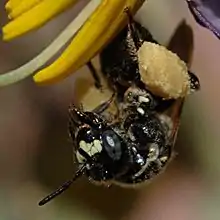Protandrena
Protandrena is a genus of mining bees in the family Andrenidae. Depending upon whose definition of the genus one follows, there are anywhere from 50-180 described species in Protandrena; traditional classifications recognize 7 subgenera, some of which are sometimes elevated to genus rank, and other classifications place many of these species in the related genus Pseudopanurgus (e.g.[1]), leaving Protandrena with a much smaller constituency.[2] In the most inclusive definition, they are found from Canada through Argentina.[3] However, there is current disagreement whether the Protandrena in South America belong to different genera, in which case the genus extends only as far south as Panama.[4] They are solitary bees.[4]
| Protandrena | |
|---|---|
 | |
| Scientific classification | |
| Kingdom: | Animalia |
| Phylum: | Arthropoda |
| Class: | Insecta |
| Order: | Hymenoptera |
| Family: | Andrenidae |
| Subfamily: | Panurginae |
| Tribe: | Protandrenini |
| Genus: | Protandrena Cockerell, 1896 |
| Subgenera (disputed; see text) | |
| |
Morphology
Protandrena bees are typically slender black bees. They frequently have yellow on the face and pronotum. They could have red on the metasoma. They rarely have a green or blue tint. The forewings will have two or three submarginal cells. The photo to the right shows submarginal cells (on Lasioglossum). The three submarginal cells are near the top of the wing.[3]
.jpg.webp)
Other Identifying characteristics include [3]
- middle tibial spur on the female that is finely toothed basally and becomes coarser distally; an exception to this is the subgenus Austropanurgus, where the spur is finely toothed throughout.
- The male's last abdominal sternum has a pair of large distal lobes that are constricted at the base.
- The gonostyli are more than half as long as the gonocoxites, with the apices articulated or partly fused. The subgenus Parasarus is an exception to this, with the gonostyli being less than 1/3 as long as the gonocoxites.
Selected species
- Protandrena abdominalis (Cresson, 1878) i c g
- Protandrena amplipennis Timberlake, 1976 i c g
- Protandrena angusticeps Timberlake, 1976 i c g
- Protandrena avulsa Ramos & Melo, 2006 i c g
- Protandrena bachue Gonzalez & Ruz, 2007 i c g
- Protandrena bancrofti Dunning, 1897 i c g
- Protandrena bicolor (Timberlake, 1955) i c g
- Protandrena bishoppi Crawford, 1916 i c g
- Protandrena blandula Timberlake, 1976 i c g
- Protandrena boharti Timberlake, 1976 i c g
- Protandrena cockerelli Dunning, 1897 i c g b
- Protandrena cognata Timberlake, 1976 i c g
- Protandrena duplonotata (Timberlake, 1955) i c
- Protandrena durangoensis Timberlake, 1976 i c g
- Protandrena eclepta Timberlake, 1976 i c g
- Protandrena euphorbiae (Timberlake, 1955) i c
- Protandrena exigua Timberlake, 1976 i c g
- Protandrena fasciata Timberlake, 1976 i c g
- Protandrena foveata Timberlake, 1976 i c g
- Protandrena guarnensis Gonzalez & Ruz, 2007 i c g
- Protandrena heteromorpha (Cockerell, 1896) i c g
- Protandrena hurdi Timberlake, 1976 i c g
- Protandrena impressa Timberlake, 1976 i c g
- Protandrena irwini Timberlake, 1976 i c g
- Protandrena kansensis Timberlake, 1976 i c g
- Protandrena lateralis Timberlake, 1976 i c g
- Protandrena leucopus Timberlake, 1976 i c g
- Protandrena lipovskyi Timberlake, 1976 i c g
- Protandrena maculata Timberlake, 1976 i c g
- Protandrena marstoni Timberlake, 1976 i c g
- Protandrena maurula (Cockerell, 1896) i c g
- Protandrena maximina Gonzalez & Ruz, 2007 i c g
- Protandrena metanotalis Timberlake, 1976 i c g
- Protandrena mexicanorum (Cockerell, 1896) i c g b
- Protandrena modesta (Smith, 1879) i c g
- Protandrena nudescens Timberlake, 1976 i c g
- Protandrena pectidis (Timberlake, 1955) i c g
- Protandrena pernitens Timberlake, 1976 i c g
- Protandrena persimilis Timberlake, 1976 i c g
- Protandrena polita Timberlake, 1976 i c g
- Protandrena protuberata Timberlake, 1976 i c g
- Protandrena punctulata Timberlake, 1976 i c g
- Protandrena rangeli Gonzalez & Ruz, 2007 i c g
- Protandrena scutellata Cockerell, 1916 i c g
- Protandrena semilevis Timberlake, 1976 i c g
- Protandrena skinneri Timberlake, 1976 i c g
- Protandrena sorocula Timberlake, 1976 i c g
- Protandrena sphaeralceae Timberlake, 1976 i c g
- Protandrena swenki Crawford, 1913 i c g
- Protandrena tessellata Timberlake, 1976 i c g
- Protandrena texana Timberlake, 1976 i c g
- Protandrena tidestromiae Timberlake, 1976 i c g
- Protandrena trifoliata (Cockerell, 1896) i c g
- Protandrena trilobata Timberlake, 1976 i c g
- Protandrena unimaculata Timberlake, 1976 i c g
- Protandrena verbesinae (Timberlake, 1955) i c g
- Protandrena wayruronga Gonzalez & Ruz, 2007 i c g
- Protandrena xestops Timberlake, 1976 i c g
Data sources: i = ITIS,[5] c = Catalogue of Life,[6] g = GBIF,[7] b = Bugguide.net[4]
References
- DiscoverLife: Pseudopanurgus
- DiscoverLife: Protandrena
- Michener, Charles Duncan (2000). The Bees of the World. JHU Press. ISBN 9780801861338.
- "Protandrena Genus Information". BugGuide.net. Retrieved 2018-05-04.
- "Protandrena Report". Integrated Taxonomic Information System. Retrieved 2018-05-04.
- "Browse Protandrena". Catalogue of Life. Retrieved 2018-05-04.
- "Protandrena". GBIF. Retrieved 2018-05-04.
Further reading
- Ascher, J.S.; Pickering, J. (2019). "Discover Life bee species guide and world checklist (Hymenoptera: Apoidea: Anthophila)". Retrieved 2019-07-02.
- Michener, Charles D. (2007). The Bees of the World. Johns Hopkins University Press. ISBN 978-0801885730.